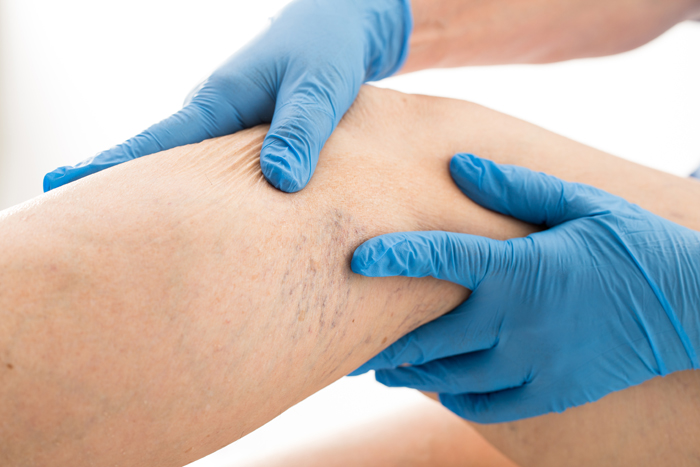Venous Insufficiency Treatment in Chembur, Mumbai
Venous diseases result from damages caused to your veins. Damaged vein valves block the circulatory system and create unusual pressure in the veins. Excessive buildup of pressure leads to twisting of the veins, swelling, obstruction, and blood clots, and eventually they develop into venous diseases.

What do we need to know about venous diseases?
Vein problems are quite common among people, but some types of venous disorders have severe health risks. So, proper diagnosis of the venous system is necessary to avoid further complications.
For diagnosis and treatment, you can visit any of the vascular surgery hospitals in Mumbai. Alternatively, you can search online for a vascular surgeon near me.
What are the causes of venous diseases?
You may know that the arterial system transports oxygen-rich blood to the outer cells, and the venous system returns the blood to the heart after utilizing the oxygen. Now, if the venous return system no longer functions properly, it leads to various venous disorders. Veins are thin-walled structures, and the vein valves ensure blood flow towards your heart. If there is damage to the valve, it may not close properly and leak blood, and thus, the circulatory system breaks down, resulting in venous diseases.
What are the types of venous diseases? What are the symptoms of venous diseases?
There are different types of venous diseases:
- Deep vein thrombosis
It is a condition that occurs when there is a blood clot in any of the body’s deep veins. They usually develop in the deep leg veins, thighs, pelvis and arms. It may be asymptomatic but might lead to pulmonary embolism (movement of blood clots into the lungs).
Symptoms:- Shortness of breath
- Swelling or pain in the foot, ankle and leg
- Cramps or soreness
- The affected area may turn red or blue
- Chronic venous insufficiency
When veins have trouble sending back blood to the heart, it leads to legs swelling, venous hypertension and skin discoloration. The malfunction of the veins and chronic insufficiency may cause venous ulcers, another disorder of veins.
Symptoms:- Itching and tingling
- Swelling and cramps
- Venous ulcers - shallow sores and leg pain
- Pus drainage from the wound
- Superficial thrombophlebitis
Suppose there is an inflammation of the vein close to the skin’s surface resulting from a blood clot. They do not travel to the lungs, but they move into deep venous systems.
Symptoms:- Fever
- Sudden swelling and redness of the leg
- Pain in the affected area
- Varicose veins
Varicose veins are abnormal, enlarged and twisted blood vessels that bulge from pooled blood. They are visible and are usually blue or dark purple in color.
Symptoms:- Burning, throbbing and swelling
- Skin discoloration and itching
- Leg pain if there is no movement of legs for extended periods.
When do you need to consult a doctor? How are venous diseases diagnosed?
Consult a vascular surgeon near you if you experience any swelling around the veins or an injury or wound that has not healed correctly. Doctors then perform Doppler ultrasound, a test to know how blood moves around the blood vessels to diagnose venous diseases. They perform some other tests like MRI and venogram to identify the type of venous disorder.
You can request an appointment at Apollo Spectra Hospitals, Chembur, Mumbai.
Call 1860 500 2244 to book an appointment.
What are the treatment options for venous diseases?
The primary goal of the treatment is to reduce symptoms like swelling and pain and reduce the risk of complications. The most common type of treatment involves compression stockings or bandages. If there is an ulcer because of an infection or trauma, dressing the wound helps to relieve the symptoms quickly. When these non-surgical interventions cannot heal the wound, then doctors suggest surgical techniques. Debridement for venous ulcers, endovenous ablation for varicose veins, venous thrombectomy for deep vein thrombosis, valvuloplasty and ligation are some of the surgical techniques for treating venous diseases.
Conclusion:
Venous diseases occur because of damages in the deep veins of the legs. However, a minor discomfort in the legs may worsen over time and progress to various stages of chronic venous diseases, and may range from varicose veins to venous ulcers. So, immediately consult a doctor to prevent blood clots in the veins and relieve pain and sores.
With proper lifestyle changes, you can prevent chronic venous diseases. Some of them include maintaining a healthy weight, eating a healthy diet, avoiding smoking, control over chronic conditions like high blood pressure and diabetes, and regular physical exercises and strength training for hands and legs. Use compression stockings to help blood flow.
The medications are to be used only on doctor’s instructions. Some medications that relieve the symptoms are anti-inflammatory drugs to reduce swelling and pain, pain killers, anticoagulants to reduce the risk of developing new clots, antibiotics and thrombolytic agents.
Vein check measurements like light reflection rheography are a simple and effective way to diagnose venous diseases. They measure how quickly the veins refill the blood. A shorter refill time may show weakness.
Symptoms
Our Top Specialities
NOTICE BOARD
CONTACT US
CONTACT US
 Book Appointment
Book Appointment


.svg)
.svg)
.svg)
.svg)








